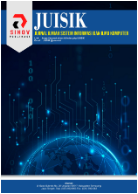Analisis Pengaruh Desain dan Fungsionalitas Website terhadap Kepuasan Pengguna Streetwear X Indonesia Menggunakan Pendekatan Model UTAUT2
DOI:
https://doi.org/10.55606/juisik.v4i3.1369Keywords:
website design, functionality, user satisfaction, UTAUT2, StreetwearAbstract
This study aims to analyze the impact of website design and functionality on user satisfaction of Streetwear X Indonesia, using the Unified Theory of Acceptance and Use of Technology 2 (UTAUT2) model. The background of this research is based on the importance of interface quality and user experience in enhancing satisfaction and the continued use of e-commerce websites, especially in the competitive streetwear industry. The independent variables analyzed include website design, which encompasses aesthetics, navigation, and visual consistency, as well as website functionality, which includes access speed, transaction ease, and interactivity. User satisfaction is the dependent variable, serving as the key indicator of the website's acceptance and user loyalty. This research employs a quantitative approach, with Partial Least Square Structural Equation Modeling (PLS-SEM) used to test the relationships between the variables and measure the impact of each factor on user satisfaction. Data was collected through questionnaires distributed to active users of the X Indonesia website, representing various user demographics. The analysis results show that both website design and functionality have a significant positive impact on user satisfaction, emphasizing the importance of both visual appeal and operational efficiency in shaping user experience. The findings offer practical implications for website managers, suggesting that focusing on developing an attractive interface, intuitive navigation, and responsive functionality can improve user experience. Therefore, optimizing design and functionality elements strategically can increase user loyalty, enhance their interaction experience, and promote the long-term sustainability of the X Indonesia website.
References
Chandra Dewi, A., Hermuningsih, S., & Wiyono, G. (2023). Analisis faktor penentu profitabilitas bank syariah di Indonesia dengan non performing financing sebagai variabel moderasi. Syntax Literate: Jurnal Ilmiah Indonesia, 8(2), 1315-1334. https://doi.org/10.36418/syntax-literate.v8i2.11430
Hidayat, T. (2024). Analisis triple bottom line pada implementasi green marketing di sektor industri Indonesia menggunakan metode SEM-PLS. Jurnal Dinamika Bisnis dan Kewirausahaan, 1(2).
Nurhalizah, S., Kholijah, G., & Gusmanely, Z. (2024). Analisis Structural Equation Modeling Partial Least Square pada kinerja pegawai PT. Bank Pembangunan Daerah Jambi. Indonesian Journal of Applied Statistics, 6(2), 125. https://doi.org/10.13057/ijas.v6i2.78921
Permana, E., Purnomo, M., Santoso, R., & Syamsurizal, S. (2021). Pengaruh agilitasi strategis terhadap sustainability competitive advantage melalui aksi kompetitif bisnis SiCepat Express. AdBispreneur, 6(1), 79. https://doi.org/10.24198/adbispreneur.v6i1.32584
Sofyani, H. (2025). Penggunaan teknik Partial Least Square (PLS) dalam riset akuntansi berbasis survei. Reviu Akuntansi dan Bisnis Indonesia, 9(1), 80-94. https://doi.org/10.18196/rabin.v9i1.26199
Wiyono, G., & Kirana, K. C. (2020). Efek impresi fintech terhadap perilaku keuangan usaha kecil menengah (UKM). Jurnal Ilmiah Manajemen dan Bisnis, 21(1), 69-81. https://doi.org/10.30596/jimb.v21i1.3889
Al-Qeisi, K., Dennis, C., Alamanos, E., & Jayawardhena, C. (2014). Website design quality and usage behavior: Unified theory of acceptance and use of technology. Journal of Business Research, 67(11), 2282-2290. https://doi.org/10.1016/j.jbusres.2014.06.016
Chen, H., Papazafeiropoulou, A., Chen, T. K., Duan, Y., & Liu, H. (2021). Exploring the commercial value of social media: An empirical study. Information & Management, 58(2), 103307. https://doi.org/10.1016/j.im.2020.103307
Ho, C. H., & Lim, C. Y. (2018). Usability and aesthetics in website design: User preference and performance. International Journal of Human-Computer Interaction, 34(3), 235-245. https://doi.org/10.1080/10447318.2017.1343910
Kusumawati, R., & Santoso, D. (2019). Legal protection of brands in creative industries: A study on Indonesian trademark law. Yustisia Jurnal Hukum, 8(1), 45-56. https://doi.org/10.20961/yustisia.v8i1.33512
Li, H., & Suh, A. (2015). Factors influencing website usability in e-commerce: A cross-national study. Electronic Commerce Research and Applications, 14(6), 389-399. https://doi.org/10.1016/j.elerap.2015.03.002
Pratama, Y. A., & Pramudiana, R. (2020). Digital marketing strategy for Generation Z: Case study in fashion e-commerce. Journal of Business and Management Review, 1(5), 336-345. https://doi.org/10.47153/jbmr15.352020
Putra, I. G. B. (2021). Trademark protection and creative economy development in Indonesia. Hasanuddin Law Review, 7(2), 123-136. https://doi.org/10.20956/halrev.v7i2.2956
Rose, S., Hair, N., & Clark, M. (2012). Online customer experience: A review of the business-to-consumer online purchase context. International Journal of Management Reviews, 14(1), 24-39. https://doi.org/10.1111/j.1468-2370.2011.00315.x
Susanti, Y., Nurlaela, S., & Hidayat, A. (2022). The effect of website quality on customer satisfaction and loyalty in fashion e-commerce. Journal of Digital Marketing and E-commerce, 4(1), 55-65. https://doi.org/10.26740/jdme.v4i1.21220
Tarigan, E., & Siagian, H. (2021). The role of website design and e-service quality in influencing online purchase intention. Jurnal Manajemen, 25(2), 211-225. https://doi.org/10.24912/jm.v25i2.801
Downloads
Published
How to Cite
Issue
Section
License
Copyright (c) 2025 Jurnal ilmiah Sistem Informasi dan Ilmu Komputer

This work is licensed under a Creative Commons Attribution-ShareAlike 4.0 International License.













